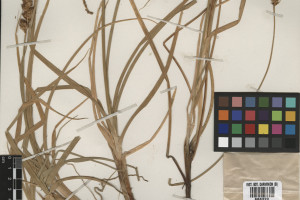Descripcion
Rizoma leñoso. Tallo de 15-30 cm de alto, triquetro, escabroso en lo alto. Hojas más cortas que el tallo, de 3-4 mm de ancho. Espiguillas numerosas, andróginas, dispuestas en espiga de 3 cm, subdensa, generalmente ebracteada; glumas ovales de color herrumbroso de bordes hialinos anchos. Utrículos poco más largos, ovales, plano-convexos, lisos, lustrosos, paucinervados en el dorso, de base esponjosa, brevemente estipitados, de bordes engrosados, gradualmente atenuados en rostro mediocre brevemente bidentado, estigmas 2.
Distribucion y Habitat
Hallado en Bolivia, sur de Chile, en la Argentina en Jujuy, Salta, Catamarca, La Rioja, Tucumán, Córdoba, la Patagonia. Distribution: Southern Andes, from Mendoza Province in Argentina, north to northern Argentina, disjunct in Sierra de Achala (Córdoba Province) and local in northern Chile (although see comments under C. ecuadorica), doubtful in Bolivia [83 BOL? 85 AGE AGW CLN].
Sinónimos
Carex macrorrhiza Boeck.
Bibliografía
Ejemplares de referencia
| Colector | N° Colect. | Especie | Departamento | Provincia | Imagen |
|---|---|---|---|---|---|
|
|
2650 | Famatina | La Rioja |

|
|
|
|
3201 | Famatina | La Rioja |

|
|
|
|
14045 | Los Andes | La Paz |

|
|
|
|
2819 | Calamuchita | Córdoba |

|
|
|
|
4292 | RIOC | Río Cuarto | Córdoba |

|
|
|
10234 | San Alberto | Córdoba |

|
|
|
|
30411 | Tilcara | Jujuy |

|
|
|
|
9323 | Cochinoca | Jujuy |

|
|
|
|
20661 | Humahuaca | Jujuy |

|
|
|
|
20661 | AC | Humahuaca | Jujuy |

|
|
|
11408 | Santa Catalina | Jujuy |

|
|
|
|
1666 | - |

|
||
|
|
600 | La Rioja | |||
|
|
600 | La Rioja | |||
|
|
89 | CORD 65922 | Córdoba |

|
|
|
|
3 | - |

|
||
|
|
1658 | Andalgalá | Catamarca |

|
|
|
|
540 | - |

|
||
|
|
7635 | Malargüe | Mendoza |

|
|
|
|
7635 | Malargüe | Mendoza |

|
|
|
|
10883 | Coronel Felipe Varela | La Rioja |

|
|
|
|
11408 | Santa Catalina | Jujuy |

|
|
|
|
13917 | Coronel Felipe Varela | La Rioja |

|
|
|
|
13930 | Coronel Felipe Varela | La Rioja |

|
|
|
|
660 | Famatina | La Rioja |

|
|
|
|
1332 | Humahuaca | Jujuy |

|
|
|
|
8964 | Los Andes | Salta |

|
|
|
|
14375 | Aisén | Aisén |

|
|
|
|
12211 | Santa María | Catamarca |

|
|
|
|
8430 | Iquique | Tarapacá |

|
|
|
|
10984 | Yavi | Jujuy |

|
|
|
|
12725 | - |

|
||
|
|
21177 | - |

|
||
|
|
11331 | Cochinoca | Jujuy |

|
|
|
|
9174 | Zapala | Neuquén |

|
|
|
|
9210 | Zapala | Neuquén |

|
|
|
|
10820 | Zapala | Neuquén |

|
|
|
|
11275 | Zapala | Neuquén |

|
|
|
|
11296 | Zapala | Neuquén |

|
|
|
|
11533 | Zapala | Neuquén |

|
Nombre Vulgar y Usos
Tipo y Observaciones
Material Tipo: Lectotype (designated by Wheeler, 2006): ARGENTINA:
La Rioja, Sierra Famatina, en las cercanías de la
quebrada, 2 a 4 leguas arriba del Vallecito, 21 Jan 1878,
Hieronymus & Niederlein 600 (S-07-12262 digital
image!; isolectotype: SI digital image!, photograph
at F!).
[G. A. Wheeler, Hickenia 3: 259–266. 2006].
Observaciones: Iconography: Figures 2S, 3S. See additional figures
in Barros (1947: tab. 173) and Wheeler (2009: 332,
fig. 298).
Etymology: From the Greek makros, long, large,
and rhiza, root, ‘large rooted’, referring to the thick
elongated rhizomes of this species.
Notes: Kükenthal (1909) presumably studied at B
the original material of the names C. macrorrhiza
and C. curvifolia (now destroyed), synonymizing the
latter to the former. We follow Kükenthal (1909) and
Wheeler (2006) and keep C. curvifolia as synonym of
C. macrorrhiza.
The plant pictured in Barros (1935: 196) does not
match the characters of C. macrorrhiza regarding the
utricle, although the plant that is represented for the
whole habit strongly resembles the species. The plate
might represent a large specimen of C. ecuadorica or a
mix of different taxa.The records from Uruguay (Zuloaga et al., 2020;
Govaerts et al., 2020+) seem to be at least partly based
on specimens of C. divisa (e.g. URUGUAY: Soriano,
Herter 94293, US-02141036!). Wheeler considered
such records doubtful (Wheeler, 2006). The presence of
C.macrorrhiza, an Andean species, in Uruguay also seems
improbable to us, so we do not include the country under
the distribution of the species. All the studied records
from Bolivia are here identified as C. ecuadorica, thus
the presence of specimens morphologically assignable to
C. macrorrhiza in Bolivia needs confirmation.
Aspecto general
.jpg)
